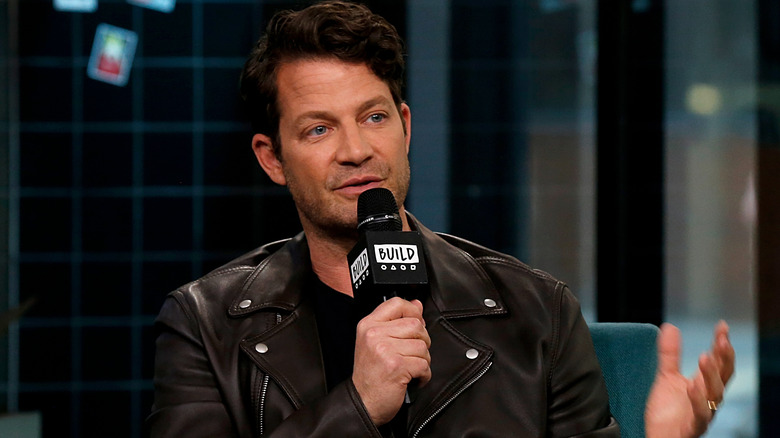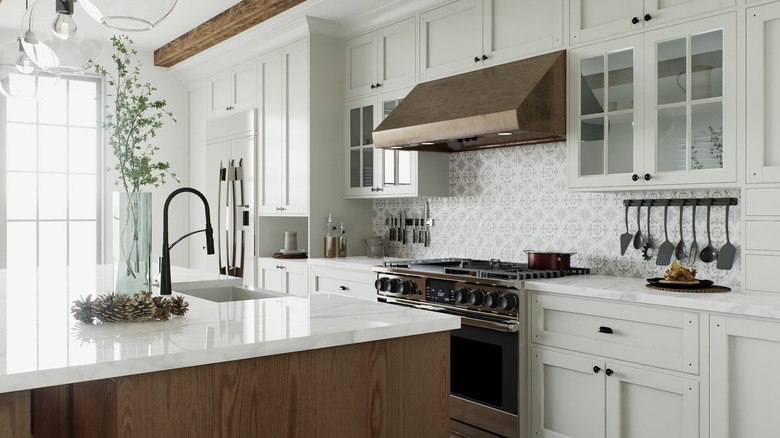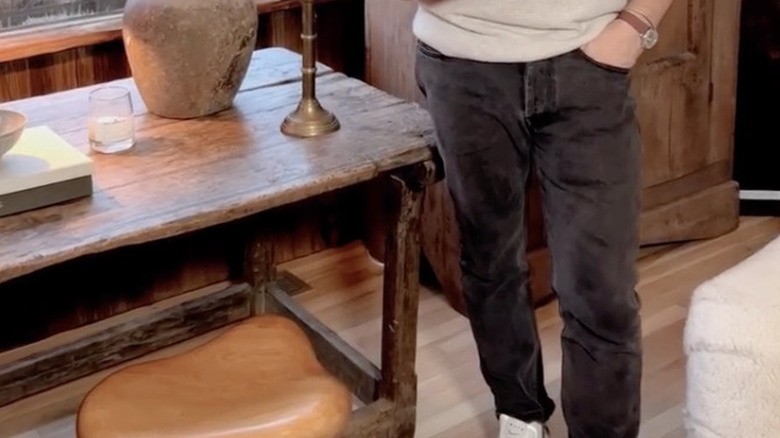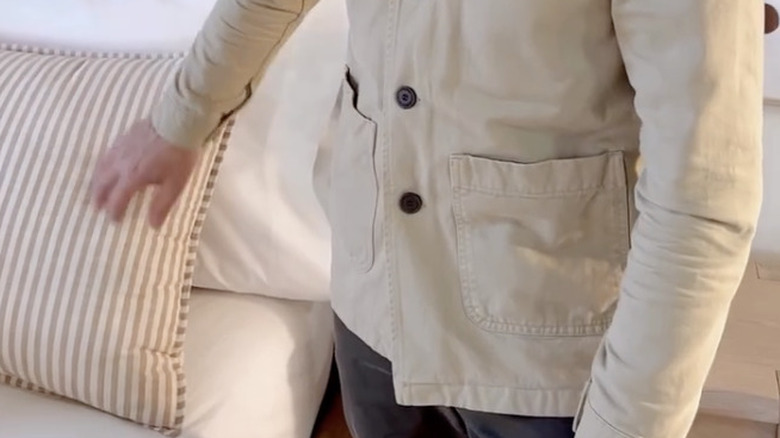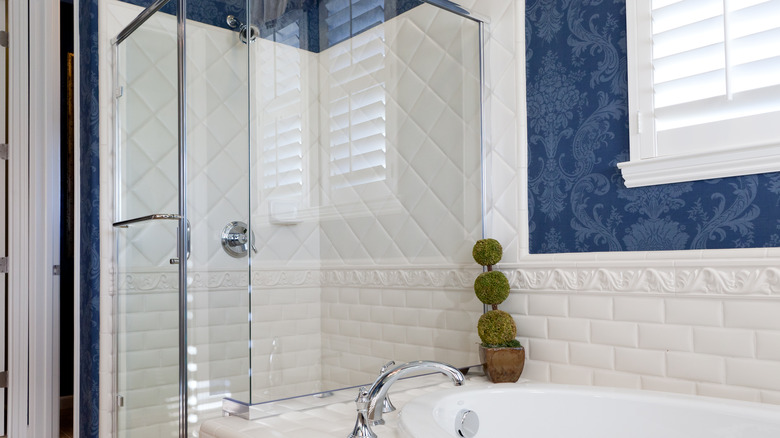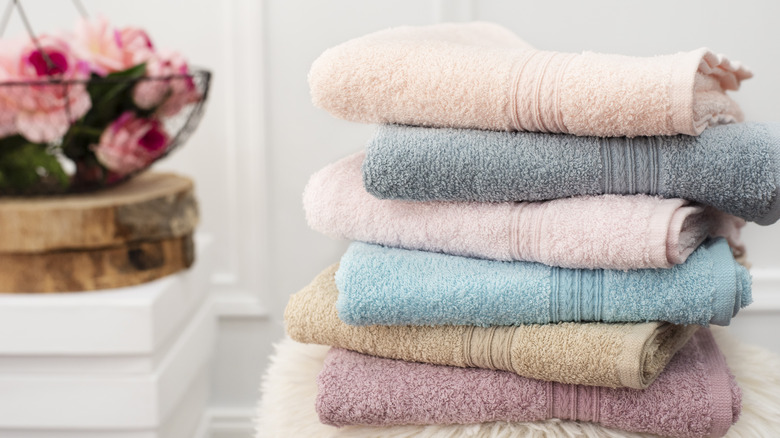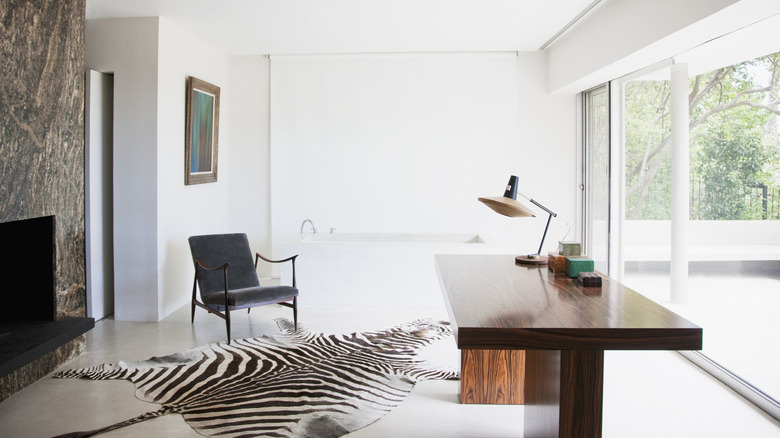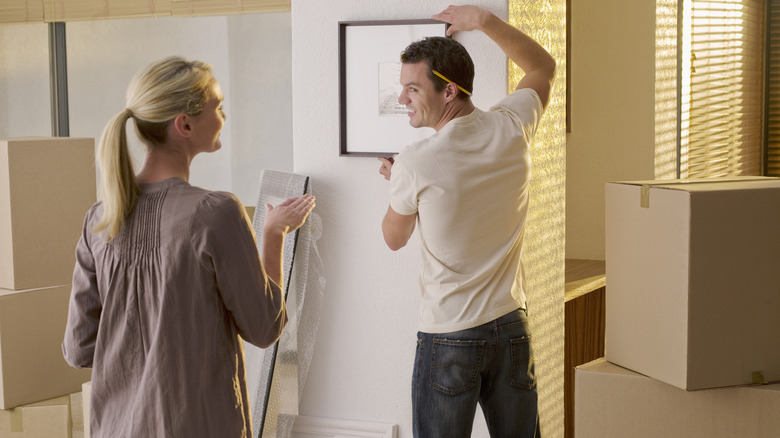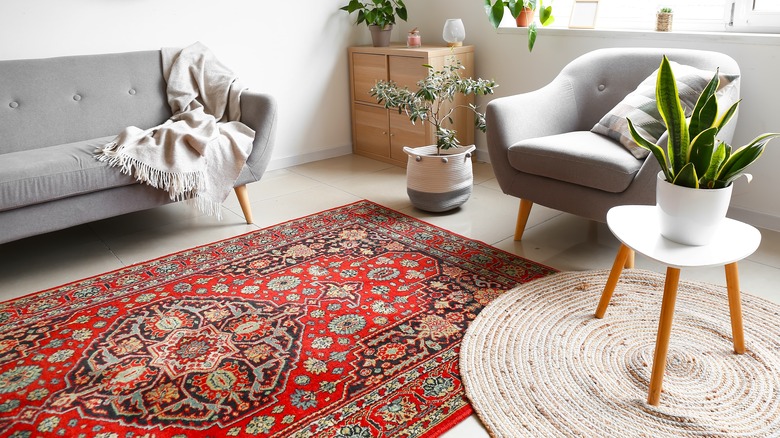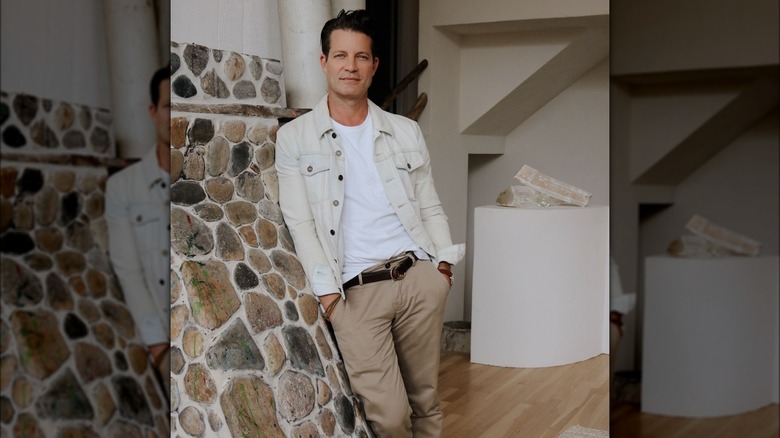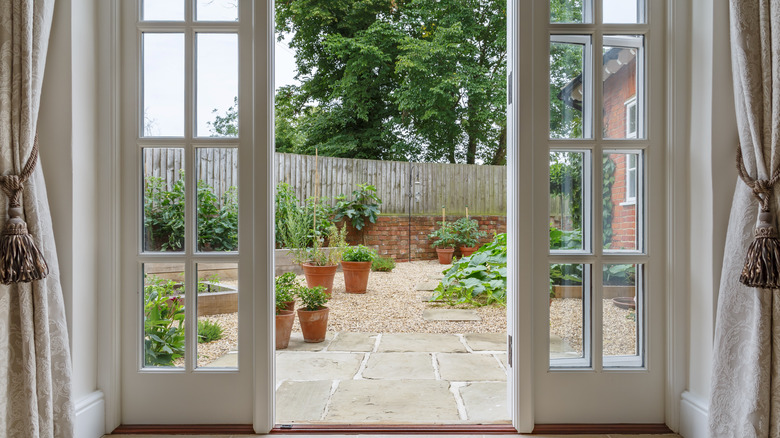Home Features That Will Never Go Out Of Style, According To HGTV's Nate Berkus
Home design might seem like it's an unsteady industry. You might have noticed that trends come and go so quickly that it can be difficult to know what styles will go the distance. But none of this has to be true, according to Nate Berkus. The HGTV star has decades of experience in design behind him and is insistent on one thing: To achieve the perfect home, you need to stop following trends and stick to the classics instead. "The story of what a successful interior communicates is who you are, who you've been, and who you aspire to be," he told the Star Tribune when asked about how he likes to put together a space.
Berkus describes himself as "vehemently anti-trend" per HGTV. He wants the homes he creates with his clients to stand the test of time. There is no use pouring thousands of dollars and hours of effort into a home design only for it to be "out" a few years later. And to do this, "you have to really be trend-averse," he said. "You have to spend the effort and the time considering what you want." We've rounded up the home features that Nate Berkus thinks will never go out of style — because they were never just trends in the first place. Instead, these designs have been holding their own for generations and have rightly earned their place as classics.
White kitchens are classic for a reason
It seems like every HGTV show suggests a white kitchen. You also see them all over Instagram and Pinterest as the ideal for this heavy-traffic room. And there is a good reason for it: They work! However, even Berkus admits that he knows most people might feel jaded about them. Yet even though white kitchens are popular, they are not overdone. "Our eyes get tired of seeing the same thing over and over. When a client asks us for a white-on-white kitchen, my business partner and I are like: Oh, no, okay, we'll do another white kitchen. I know a lot of designers feel that way," he told Domino.
Yet people love them for a reason. White kitchens will never go out of style. White cabinetry, countertops, and walls can visually expand the space, making it feel larger and more open. White kitchens also often exude a sense of luxury and sophistication, reminiscent of high-end homes and luxury hotels. You can adapt white to fit your style be it modern, traditional, farmhouse, or minimalist. And Berkus agrees, saying, "It's timeless, and for most people, it's the largest investment they're going to make in their home." If you are going to spend that much money, you don't want to be remodeling again in a few years.
Rustic wood furniture brings character to a home
There's a reason you see wooden furniture in museums of homes from hundreds of years ago. It's a classic material that has been, and always will be as far as Nate Berkus is concerned, in fashion. "One thing I've always gravitated towards, and I think actually stands the test of time, are rustic wood pieces of furniture in their original finish, nothing fancy," he shared on Instagram. When motioning to a piece of furniture from his own home, he continued, "This table Jer and I found on a trip to Peru, which was incredible that we were able to get it back here. And it's been in every single home of ours since then."
Wood goes with nearly every style of home you can think of. Mid-century modern? Check! Art Deco? Also check! Classic farmhouse or Cape Codder? Wood works there, too. As Berkus recommends, you don't need to paint the furniture to keep it relevant as the best paint colors tend to come and go with trends. Instead, be sure your furniture has a nice polished finish to keep it in style for years to come. This is typically enough to do the trick.
Stripes are an easy way to incorporate patterns
If you feel like your home is a bit plain and want to begin incorporating patterns without going overboard, Berkus recommends reaching for stripes as a great starting point. "Did you ever wonder why people decorate with stripes so often?" he asked in an Instagram reel, referring to the Painted Stripe Quilt Set from his Nate Home collection. "They're very easy to incorporate into your space," he explained. "It's kind of like baby steps into embracing pattern. I know you can't go full floral or paisley." He then emphasized that even the thinnest stripes in the most neutral colors are still patterns and can be treated as such in design. You don't need to be wary of them, as they have remained classic.
There are many different types of stripes to choose from, whether you are selecting a couch, bedspread, or even wallpaper. Hairline stripes are the smallest and are nearly a whisper of pattern. Next come pinstripes which you are probably familiar with from men's suits. Next still are candy stripes, which are usually about an eighth of an inch away from their neighbors. They tend to be quite bold. While most colors work with all patterns, stay away from black and white with candy stripes as they can begin to look a bit jailhouse — which is probably not the aesthetic you're searching for.
Wallpaper is always in if done correctly
Whether or not to include wallpaper in your house is often the subject of fierce debate among design enthusiasts. However, Berkus thinks that wallpaper will never go out of style with one condition: It has to be done correctly. "I really like wallpaper when it's used in a space you wouldn't necessarily expect," he told Livingetc. As we know, Berkus is a big fan of patterns. If you want to level up from stripes (or are looking for more ways to include them in your home), he's a fan. "There's something that becomes really impactful about an all-over pattern," he continued, adding that he and his husband, designer Jeremiah Brent, have "a moody, cool forest wallpaper that feels like the perfect juxtaposition to the city outside."
When installing wallpaper in your own home, it's important to make sure you won't have to swap it out anytime soon due to overuse. To prevent this, consider the location and purpose of the wallpapered area. Vinyl wallpaper is durable and suitable for high-traffic areas like kitchens and bathrooms, while paper or fabric wallpapers may be better for low-traffic areas like bedrooms or accent walls. Another key tip is to measure twice and cut once. It's better to have a bit extra of the material than to run out of it halfway through the project.
Comfortable textiles will last you a lifetime
One of the best things you can do for a home that always stays in style is investing in textiles that will go the distance. Berkus told Livingetc that nicer things tend to last longer. "Nothing feels more luxe than a fresh set of fluffy towels," he added. In fact, he is so passionate about textiles being the foundation for any timeless home, that he told the outlet it was one of the reasons behind starting his decor line, Nate Home. So while you might think grandma's quilt is a bit tacky, home features like this actually add great character and value to your space.
A great way to ensure you get the most use out of your textiles is to have more than one set of items and rotate through them. This is things like throw pillows, blankets, and area rugs, so you can distribute wear and tear more evenly. Rotating generally helps to prevent excessive fading, pilling, or fraying of the fabrics. And of course, following Berkus' advice, you should purchase high-quality textiles made from durable materials. While initially more expensive, these quality textiles are more likely to withstand frequent use and washing, ultimately saving you money in the long run.
Curated items for your lifestyle
Berkus is a fierce advocate of enjoying the style of your home because you actually like it, not because you thought it was in style. If you curate decorations and furnishings that stand out to you, they will never go out of style. "The way I define 'more is more' is more sentiment, more practicality, more thoughtfulness. It's about really getting the most out of a space," Berkus told Artful Living. He insists that if we design our homes to meet our unique needs, we will never grow tired of them. "It's, I want a chaise near that window for reading. I want a desk that looks beautiful when I'm not on my computer," he continued.
Acknowledging the sudden lifestyle shift that many families experienced during the COVID-19 pandemic, he went on to say that sometimes there must be flexibility in how we arrange our homes. "The thing is to make my house rise up to greet me — for whatever my needs are right now," he said. Over the years, what a perfect, stylish house might look like will change for you. As your family grows and shrinks, as you get a new job, or have different accessibility needs — your home will look different. The key to maintaining style, Berkus believes, is to roll with it.
Your personal style is already a success
All advice aside, Berkus understands that the most important thing to designing a home that will never go out of style is choosing options that you personally like the look of. The best way to do this, he thinks, is to look back at the designers of the past to see what pops out to you. "Take the time not to look forward but to look back and look at historic interiors, the classic famous interiors that have stood the test of time," he told the Star Tribune. "Take stock of the decisions that you've made that have been successful and give yourself credit for them." That is, each new living space doesn't exist in a vacuum. You have likely put together rooms (or at least picked out a piece of artwork for your dorm's wall) at one point or another. Berkus urges you to remember what you liked about where you currently live and bring those successes into your future spaces, too.
Once you notice your personal wins, he advises you to "start researching and trying to collect a visual diary of ways to continue with the things that have worked for you." If you love something, Berkus says, in essence, it can't go out of style.
Vintage lighting, mirrors, and decor stand the test of time
Berkus thinks that adding vintage pieces to your home will ensure the features will never go out of style as they have already stood the test of time. "For my own home and in client projects, we always reach for vintage pieces, and things that have age and patina," he told Livingetc. The best thing about these items is that are easy to readjust if you move house or need to rearrange your home to better fit your needs. They "don't tie you to any specific design aesthetic or trend and can move around in your home as you and your space evolves," he said. Even in his own home, there are plenty of pieces "that have moved from home to home over the years, and they still feel fresh and interesting every time they land somewhere new."
Some of the best places to find vintage things for your home are on resale platforms like Facebook Marketplace. Of course, you can always try your luck with local flea markets or craft fairs — but the great thing about online resources is that you can search more specifically for what you are looking for. You don't have to risk just happening upon the perfect item. Instead, set an alert for "vintage rugs" and make the entire process much easier on yourself.
Neutrals are always an easy go-to
Classic colors are classic for a reason. Nate Berkus is a big fan of neutrals and finds that they pop up in his life in unexpected ways. "Unintentionally matching the house again," he posted on Facebook. "For me, it will always be neutrals for the win. Whether it's my wardrobe, or my decor." Neutrals never go out of style because they effortlessly blend into the background. Unlike popular colors of the year that are meant to stand out, neutral colors do more heavy lifting behind the scenes. "Whether that's bringing in a certain design style or color scheme, a neutral palette literally provides a blank canvas," Berkus told Homes and Gardens. From the safety of colors like brown, black, white, gray, and shades of beige, you can build a room that is soft or bold — all depending on your personal style.
"I'm not the hugest fan of bright paint colors or accent walls; rather, experiment by painting niches, like shelving," Berkus continued. These things are easy to change if your coral pink or teal blue choice fades from popularity in years to come. You would be looking at an afternoon of work and $20 on a can of paint, as opposed to the greater amount of effort it takes to repaint an entire wall. Or even worse, your entire house.
French doors bring classic charm to a home
Nate co-hosts "The Nate and Jeremiah Home Project" with his husband Jeremiah Brent. In the episode "Fresh Start," the pair revealed something you should always be on the lookout for: French doors. These are elegant, versatile architectural features that first started popping up in France during the Renaissance period. You will recognize them by their double doors with multiple glass panels. This creates a wide, inviting entryway that allows natural light to filter through. The glass panels enhance the doors' aesthetic appeal and provide a clear view of adjoining spaces.
These hinged doors are commonly used to connect interior rooms or provide access to outdoor spaces, blurring the lines between indoor and outdoor living areas. French doors are a popular choice for homeowners and architects, and have been for centuries. For this reason, Nate and Jeremiah are thrilled when their team comes across the doors. Although this example has been altered with wooden panels installed over the glass, these are easily removed, restoring the door to its original glory for the homeowners. When designing your first home, or renovating the space you already own, you can't go wrong with French doors. They are the perfect "moment" as Brent says during the episode.
